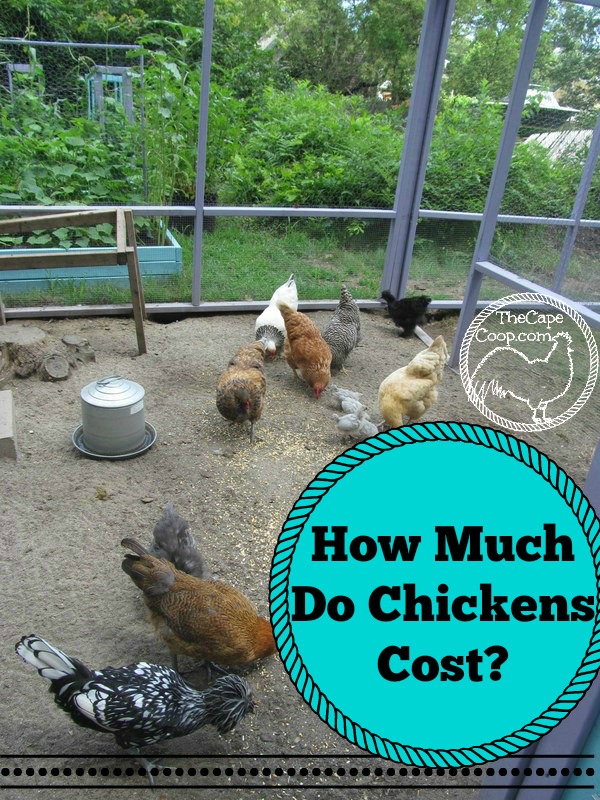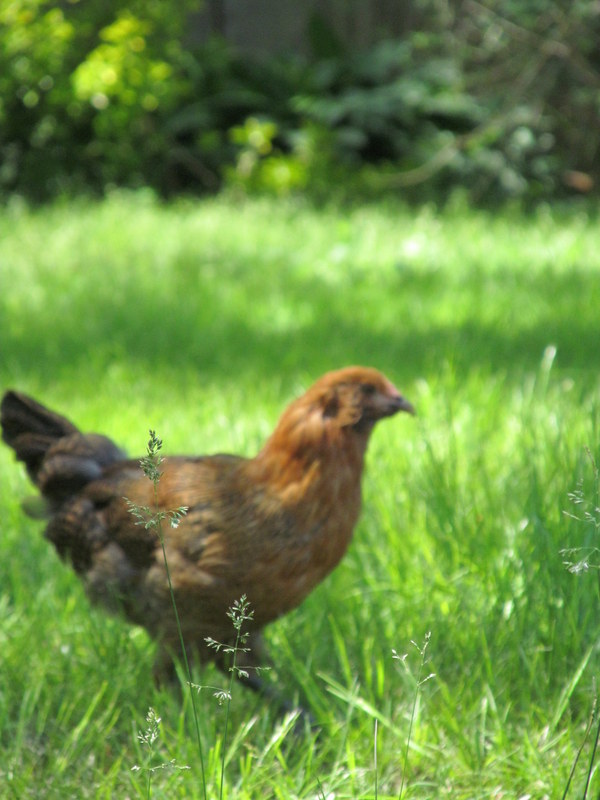---------------------------------------------------------
Once you have the chickens & the coop set up, you will see maintaining your flock is relatively inexpensive.
One time costs:
Coop & Run: $ – $$$$$$ it all depends on how handy & resourceful you are and how many bells & whistles you want. You can salvage scrap wood & wire and build a coop for next to nothing or spend thousands on a custom build
Feed Supplies: $50-$100 – you will need feeders for food, water & a rodent proof container for extra feed
Wire Dog Crate: $25-$50 -find one used on Craigslist or at a yard sale, buy the biggest one you can afford and try to find one that folds flat when you aren’t using it. Trust me, you will be happy to have it on hand when you need it. You will use it when introducing new chickens to the flock, as a quarantine cage for sick or injured birds, a broody pen if you have a hen hatching chicks and her flock mates are bothering her, transporting chickens, or as a time out cage if you have a bully who needs to be put in her place. Click here to see how I built a mini coop for $2 perfect for this use!
Chickens: $3-$50++ each – There are a couple factors here. Chicks will always cost less than full grown hens, hens usually cost more than roosters, and rare breeds can make costs skyrocket (I’m not exaggerating to say some people will pay hundreds of dollars per chicken for quality stock, rare breed chickens). If you buy them as chicks you can expect to pay a $3-$10 per chick for most breeds, adult hens about $25-$50 per hen for most breeds.
Ongoing costs:
Feed: about $3-$4 per hen per month (they each will eat about 7.5 pounds feed per month), less if you supplement their feed with kitchen scraps or free ranging. Commercial feeds are formulated to be complete nutrition for your bird, so you don’t need to add in anything additional. Many small flock owners enjoy spoiling their flock with treats, however. Chickens love dried bugs like meal worms, sunflower seeds, scratch grains, & oyster shells.
They also enjoy a wide variety of fruits & vegetables. They will happily eat table scraps like leftover lettuce from last night’s salad, uneaten crusts from your child’s sandwich, melon rinds, crushed eggshells, plain pasta, and so much more. Feeding your flock food scraps is a great way to treat them, reduce your trash, and save money! Treats should only make up about 10% of your hen’s diet.
Litter: about $5 month – pine shavings or straw are two of the most popular options for coop litter
Sand: we spend about $60 a year for sand in our run (so to stick with the monthly budget numbers, $5 month). This gets us about twenty 50 pound bags of sand at the home improvement store to replenish the sand in the run area. Even if you don’t use it to cover your run the chickens will still need some sand to eat for grit.
Health Costs: minimal – we try to raise our chickens as naturally as possibly, but we occasionally have to buy medications (occasional deworming, mite treatment, respiratory medicine, treatment for wounds). Once you have a good chicken first aid kit stocked you just need to replace things as they are used or expire. Click here to see what’s in my chicken first aid kit
Small Flock Example: For someone keeping a small flock of 6 hens, you can expect about $20 a month in feed (non-organic), $5 a month in pine shavings, and about $60 per year to replenish sand in the run. For the entire year, expect to spend about $360
Monetary Benefits of Chickens
Eggs: The most obvious financial advantage is eggs. Farm Raised eggs generally sell for about $5-$8 dozen depending on where you live. Chicken laying habits vary widely according to their diet, age, breed, & amount of sunlight (they need about 14 hours of light to lay an egg). In the spring & summer you might get 6-7 eggs per week per bird. In the middle of winter you might have days with no eggs at all.
Chickens lay less in the winter because the daylight hours are shorter. You can “trick” them with daylight lighting inside the coop, but many chicken keepers just let them have the winter off. Click here to read more about the pros & cons of supplemental lighting in winter. Click here to read about reasons that healthy hen might not be laying eggs
A Small Flock Example: Buff Orpingtons are a popular breed of chicken that lay fairly well. A young Orpington who is well cared for might average 260 eggs per year. If you had a flock of 6 Orpingtons laying at that level and you sold all the eggs for $5 dozen, you would make $650 in a year.
Cost is $360 and income is $650 per year, on paper, this looks great right?! In practice, things are not this neat. The 260 eggs per year might be the case for chickens under 3 years. As they age, chickens lay less and less, and they can live for 10 years or more! The chicken breed you choose also plays a large role. While Buff Orpingtons might lay 260 per year, Silkies only lay about 100 a year, Polish chickens about 180, Rhode Island Red and production breeds might top over 300 a year. If you have a mixed breed flock with mixed ages you will have mixed results. Additionally, that figure doesn’t include any treats, supplements, equipment, and your time.
Commercial chicken farms usually process hens over 2-3 years old to replace them with new layers. Some backyard farmers do this as well, using their chickens as dual purpose – eggs & meat. Some backyard farmers think of their chickens as pets and would not think of eating them. If you do not process older birds, as your flock ages you will get less eggs. At 6,7,8 years old you might only get 30-40 eggs per year per bird. Your feed costs will remain the same, but the return will be much lower. It’s a good excuse to add more birds every couple of years, but you need to have the available space for this. click here to read about dealing with aging hens
Benefits Beyond Eggs
Compost: Chicken manure is some of the most prized fertilizer around for it’s high nitrogen content. Every couple years I used to have 5 yards of compost delivered to replenish my garden beds for about $150, and that was just composted leaves, not the rich, complex compost my chickens give me! The chickens give me plenty of compost for free now, so that is money saved right there. If you aren’t a gardener, you can still use it to fertilize your lawn or bushes organically (just remember chicken manure needs to “age” for 6-12 months first)
Chicks: If you have a rooster, you can have the added benefit of breeding. It’s not something I do because all of my chickens are different breeds. I’d likely only net a few dollars per chick for barnyard mix chicks and that is not worth the headache for me. But if you were to keep a flock of a single breed you could make significantly more than that, especially if you are raising a rare, desirable breed. You also could sell fertilized, hatching eggs for people to hatch on their own. There are some potential costs involved with breeding, like getting your flock health tested regularly and an incubator if you don’t plan to let a hen hatch the eggs out for you. You also need to make sure there will be a local market for your chicks/fertilized eggs or make plans for safely shipping them.
Insect Control: If you allow your flock to free range you can say goodbye to having your yard sprayed with harmful chemicals to control some insects. Chickens love to forage for insects and some of their favorites are pests that humans hate – grubs and ticks. A study was done in 1991 to determine the effect of chickens on tick populations. In the study, a flock of chickens was allowed to free range in a tick infested cattle field for 30-60 minutes. It was found that each chicken ingested anywhere from 3-331 ticks, with the average chicken eating over 80 ticks!









Chip
Thursday 20th of March 2025
So in total, how much does keeping 4 chickens cost???
Liz
Monday 24th of March 2025
For 4 hens you will go through about 30 pounds of feed a month, approx $12-$18 (a 50 pound bag of feed is $20-$30 depending on if you choose organic or not) and if you use pine shaving in your coop you can expect to go through 1/2 a cube of shavings a month (about $4-$5). So once you have all the equipment set up, the maintence of 4 hens should be $16-$23 a month. You can reduce these costs further by free ranging your flock if you have the space and supplementing their feed with food scraps from your kitchen.
Scott
Wednesday 5th of April 2017
looks like you spend about $1.17 per day if I figured it correctly I have 15 and 4 guineas, I get 10 to 13 eggs a day and It cost me about .87 a day for feed, I sell our eggs for 2.50 a dozen I thought this was a little high on both
Lisa
Friday 26th of February 2016
Very nice coop.
Liz
Friday 26th of February 2016
Thanks Lisa!